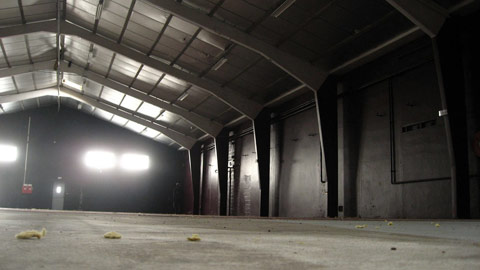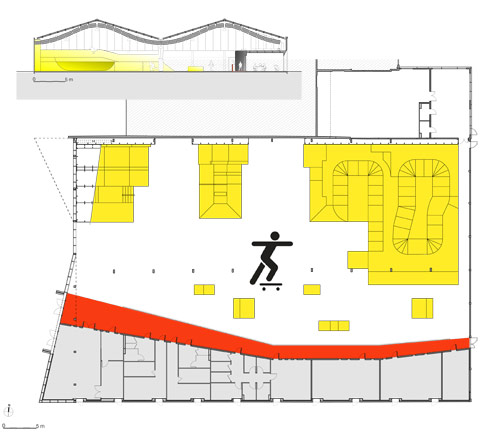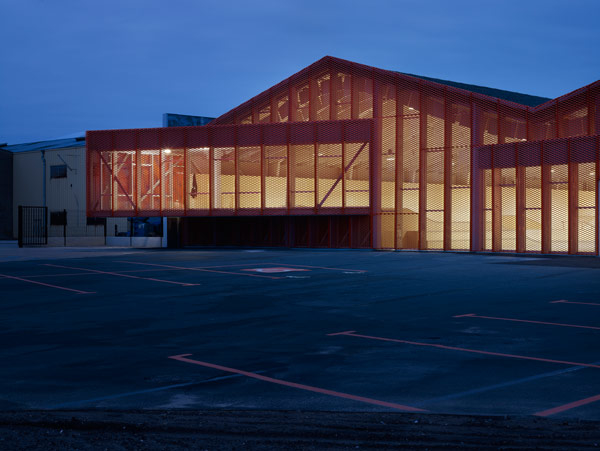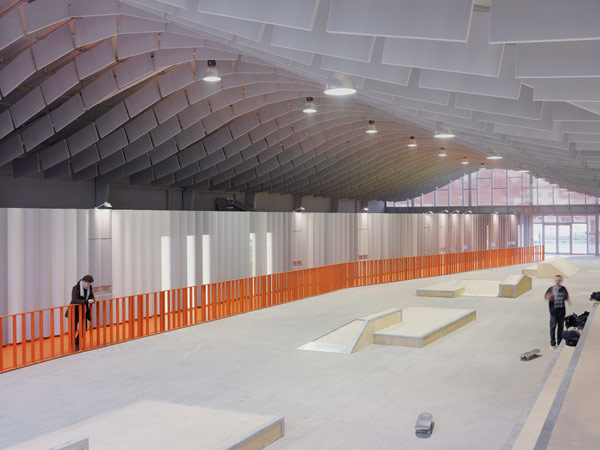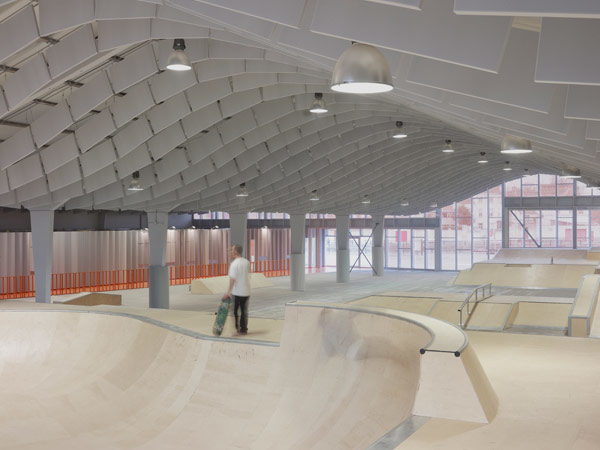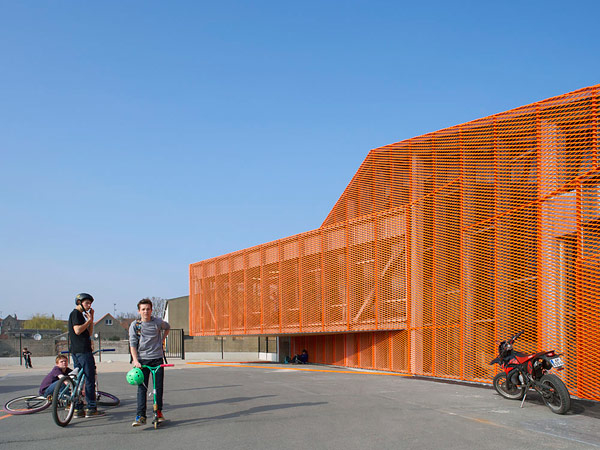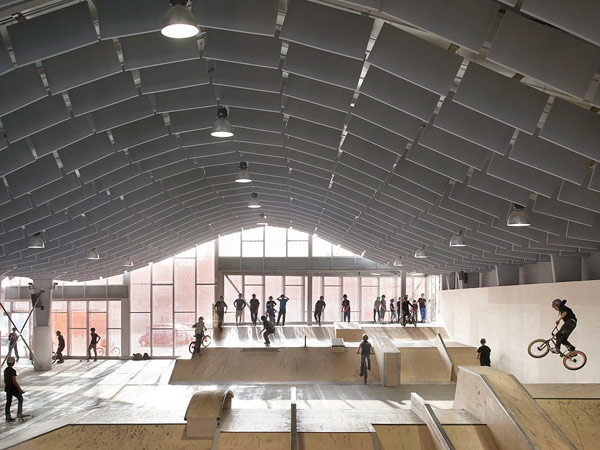Naziv projekta: ZAP’ ADOS
Lokacija: 87 quai de Lucien L’heureux 62100 Kale
Klijent: Ville de Calais
Arhitekti: Bang Architectes (Nicolas Gaudard i Nicolas Hugoo)
Inženjeri: B&R ingénierie
Program: Konverzija industrijske hale u skejt park i centar za mlade
Površina: 2 760 m²
Ukupni troškovi: 1,5M € H.T.
Početak studije: Jun 2010.
Završetak: Decembar 2011.
Fotografije: Julien Lanoo (www.ju-la.be)
Formiranje repera u urbanom pejzažu
Lokacija projekta nalazi se duž kanala u St. Pierre, u bivšoj industrijskoj oblasti Calais. Projekat je nastavak urbane obnove koju su započeli Moatti & Rivière Architects sa La Cité de la Dentelle nekoliko stotina metara nizvodno. U ovom sumornom urbanom pejzažu, konverzija postojeće industrijske hale morala je biti uočljiv poduhvat. Budući objekat potrebno je bilo osmisliti tako da signalizira svoje prisustvo i poziva potencijalne korisnike, mlade i radoznale. Čist prostor ispred objekta omogućava dobru vidljivost zapadnog zida iz okruženja. Ovaj zapadni izgled koji je kompletno redizajniran ima ulogu da emituje jak signal ka okruženju.

Reklasifikacija hale
Postojeća zgrada je klasična industrijska hala bez posebnih karakteristika, sastoji se od betonske strukture i prefabrikovanih betonskih panela i krovnih cementnih ploča. Hala je nekada služila za proizvodnju prženog kikirikija, a kasnije i u druge svrhe kao što je karting centar i na kraju je napuštena i nekoliko godina nije bila u funkciji. Objekat je bio oronuo, demoliran i postao je nestabilan. Prvi zadatak bio je da se tamna hala otvori pre radova na konstrukciji. Uklonjeni su prefabrikovani betonski paneli sa istočne i zapadne fasade kako bi se otvorili pogledi i uvelo prirodno osvetljenje u unutrašnjost objekta.
Ekspresija novog sadržaja objekta
Centar za mlade i skejt park pružaju se izvan zidova i formiraju dve izbočine koje jasno govore o novoj nameni objekta. Jedna od njih nalazi se u nivou i izlazi iz zone skejtbord kluba i centra za mlade formirajući vezu između unutrašnjeg i spoljašnjeg prostora. Druga, platforma za lansiranje, je konzolno postavljena prema prednjem trgu, gde skejteri čekaju svoj red pre zaletanja. Dva prizmatična volumena, u vidu raširenih ruku, definišu slobodan prostor prednjeg trga i pozivaju na ulazak. Arhitektonski izraz je ujednačen putem korišćenja metalnog rešetkastog omotača koji menja siluetu od hangara do prizme nastale u vidu jedne hibridne forme.
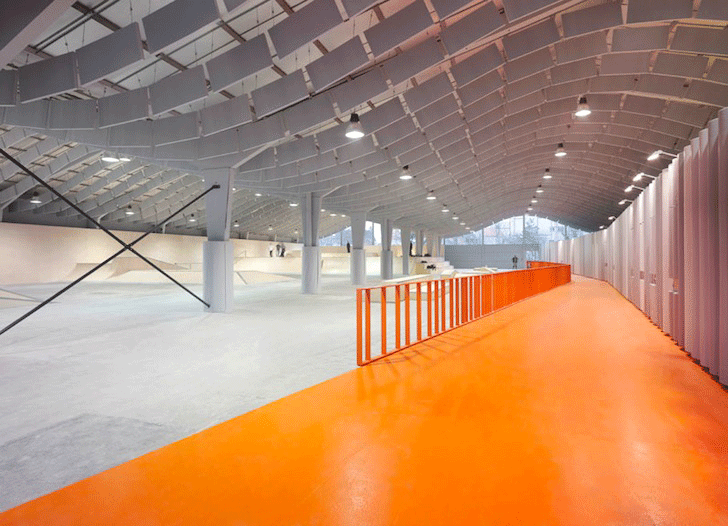
Metalna rešetka omogućava gledaocima da posmatraju aktivnosti u unutrašnjosti prostora i perforirana je nejednako od vrha ka dnu. Mreža služi kao zastor i kontroliše količinu direktnog svetla a boja je naročito upadljiva. Rešetka u boji štiti opremu i veoma je otporna i neodgovarajuća za crtanje grafita. Postavljena je i zid zavesa koja štiti objekat od vetra i smanjuje količinu buke u komšiluku. Ispred objekta prednji trg je definisan narandžastim trakama koje obeležavaju parking polja i koje se slažu sa teksturama podnih obloga.
Povezivanje dva programa
Unutar hale podužno su organizovani razni programski elementi kako bi se optimizovale dužine skejt staza i omogućio pristup centru za mlade sa južne strane. Pri ulazu u objekat sa desne strane nailazi se na nekoliko zatvorenih i grejanih prostorija. Ovaj deo je izgrađen od laganog rama i postavljen je na postojeću ploču, a ulazi su raspoređeni duž unutrašnje pešačke staze. Ova staza deo je skejt park zone, i odvojena od skejt platformi ogradom koja se prostire duž cele dužine zone. Ona omogućava gledaocima da sa sigurne pozicije posmatraju skejtere. Dugačak zid pokriven je akustičnim materijalom koji je postavljen tako da formira velike „nabore“. Ova upijajuća površina je projektovana da smanji odjeke koji nastaju od kontakta skejta sa tvrdom površinom. Zid ima vertikalne otvore koji omogućuju vizure za korisnike skejt parka i centra za mlade. Sinusoidni lejeri velikih akustičnih pregrada vise sa plafona kako bi se osigurao akustični komfor korisnika. Ovi tehnički elementi predstavljaju jeftine modifikacije koje oblikuju unutrašnji prostor i skrivaju loš izgled plafona.
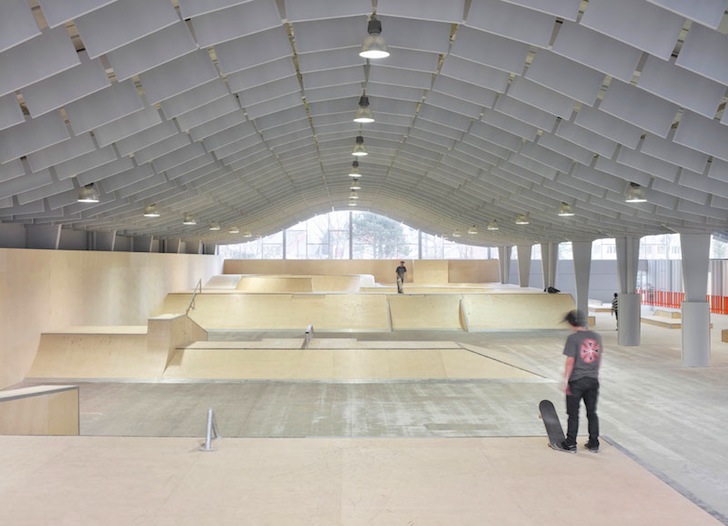
Kreiranje skejt staza
Moduli su raspoređeni u vidu traka logično postavljenim duž cele dužine hale. Na zapadnoj strani uzdignuta platforma gleda na prednji trg. Ona služi kao najviše tačka sa koje kreće zaletanje. Drugi elementi postavljeni su na istočnom kraju hale kako bi se zadržala čistina prostora. Kompleksne zakrivljene površine su stolarska dela perfektno urađena. U centru hale nalazi se “ funbox“. Zona blagih rampi je oformljena duž unutrašnje pešačke staze i ispresecana je modulima. Moduli su napravljeni od drveta (ne betona) kako bi se osigurala prilagodljivost skejt parka i reverzibilnost originalne hale.
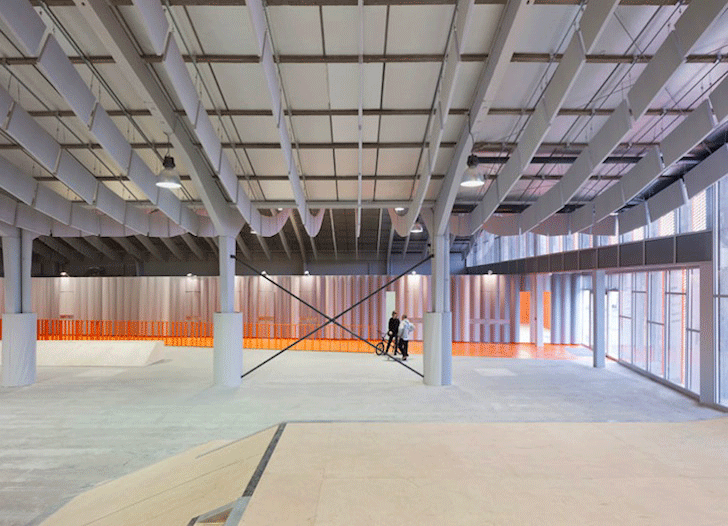
Operation’s name: ZAP’ ADOS
Location: 87 quai de Lucien L’heureux 62100 Calais
Client: Ville de Calais
Design Architects: Bang Architectes (Nicolas Gaudard and Nicolas Hugoo)
Engineer: B&R ingénierie
Program: conversion of industrial hall into Skate Park and Youth Centre
Floor area: 2 760 m²
Total cost: 1,5M € H.T.
Start of study: June 2010
Delivery: December 2011
Photo credit: Julien Lanoo (www.ju-la.be)
Create a signal in the landscape
The operation takes place along a canal in St. Pierre, which is the former industrial district of Calais. It continues the urban renewal initiated by La Cité de la Dentelle (by Moatti & Rivière Architects) located a hundred meters downstream. In this bleak urban landscape, the conversion of the existing industrial hall has to be visible. The future facility must signal its presence and invite potential users, the young and curious, to enter. The high clearance at the front of the building offers increased visibility of the west gable from the surrounding area. This gable, which has been completely redesigned, will project a strong signal into the public space.
Reclassify the hall
The existing building is a common industrial hall with no outstanding features, consisting of a concrete structure filled with precast concrete panels and a roof of cement sheets. The hall was once a roasted peanut factory, followed by various other incarnations (including a go-kart track) before being abandoned for several years. Prior to handing and processing it had been dilapidated, vandalised and had become structurally unsafe. The first task was to open the dark hall before curettage and structural recovery. This was achieved by removing precast concrete panels on the eastern and western facades to release through-views and bring natural light into the heart of the building.
Express the new assignment of the building
The youth centre and the skate park extends beyond the gable and form two protrusions, which clearly signifies that the building has a new purpose. One protrusion stands on the floor and emerges from the skateboarder club and youth centre, forming a point of contact between the inside and outside space. The other is cantilevered and a launch pad that overlooks the front square, featuring skaters waiting in turn before taking off. The two prismatic volumes, like opened arms, reclassify the free space of the front square and act as an invitation to enter. The architectural expression is unified by a common envelope made of expanded metal, which turns the silhouette from a hanger into a prism protruding from a singular hybrid form.
The metal mesh allows spectators to watch activities inside and is gradually perforated from top to bottom. The mesh acts like a shutter, controling direct sunlight and the color is stricking; it is deliberately conspicuous. This colorful mesh protects the equipment as the expanded metal is very resistant and anti-graffiti. It is doubled with a curtain wall to protect users from prevailing winds and reduce any noise nuisance to nearby houses. Outside the building the front square is treated using an orange frame to draw parking spaces, which overlap the textures of the existing floor coatings.
Linking the two programs
Inside the hall the various program elements are organised longitudinally, to optimise the length of the skate tracks and provide an entrance to the youth centre along the southern facade. When entering the building, there are a series of enclosed and heated rooms installed on the right identified by emerging prism. This set is built with a light frame and placed on the existing slab, with entrances distributed along an indoor walkway. This walkway is fully integrated into the space used for the skate park, separated using a handrail that runs its entire length. It enables „spectators“ to watch the skaters safely. The long wall is covered with an acoustic fabric stretched to form large „dimples“. This absorbing surface is designed to reduce reverberated sounds caused by skateboarding on hard surfaces. The wall is also provided with vertical windows offering views for both users of the skate park and youth centre. A sinusoid layer of large acoustic baffles is suspended from the ceiling to increase acoustic comfort for users. These technical elements offer inexpensive modifications that morph the inner space and hide the unsightly ceiling.
Create skate tracks
The modules are arranged in a strips logically oriented along the full length of the hall. On the west side a raised platform overlooks the front square. It serves as a high point: the launcher. The bowls (rare in the region) are installed at the east end of the hall to maintain space clearance. These complex curved surfaces are works of joinery and carpentry of great sophistication. In the center of the hall is the funbox. A calm initiation zone is arranged along the indoor walkway and punctuated by modules. The modules are made of wood (not concrete) to maintain the adaptability of the skate park and the reversibility of the original allocation of the hall.



